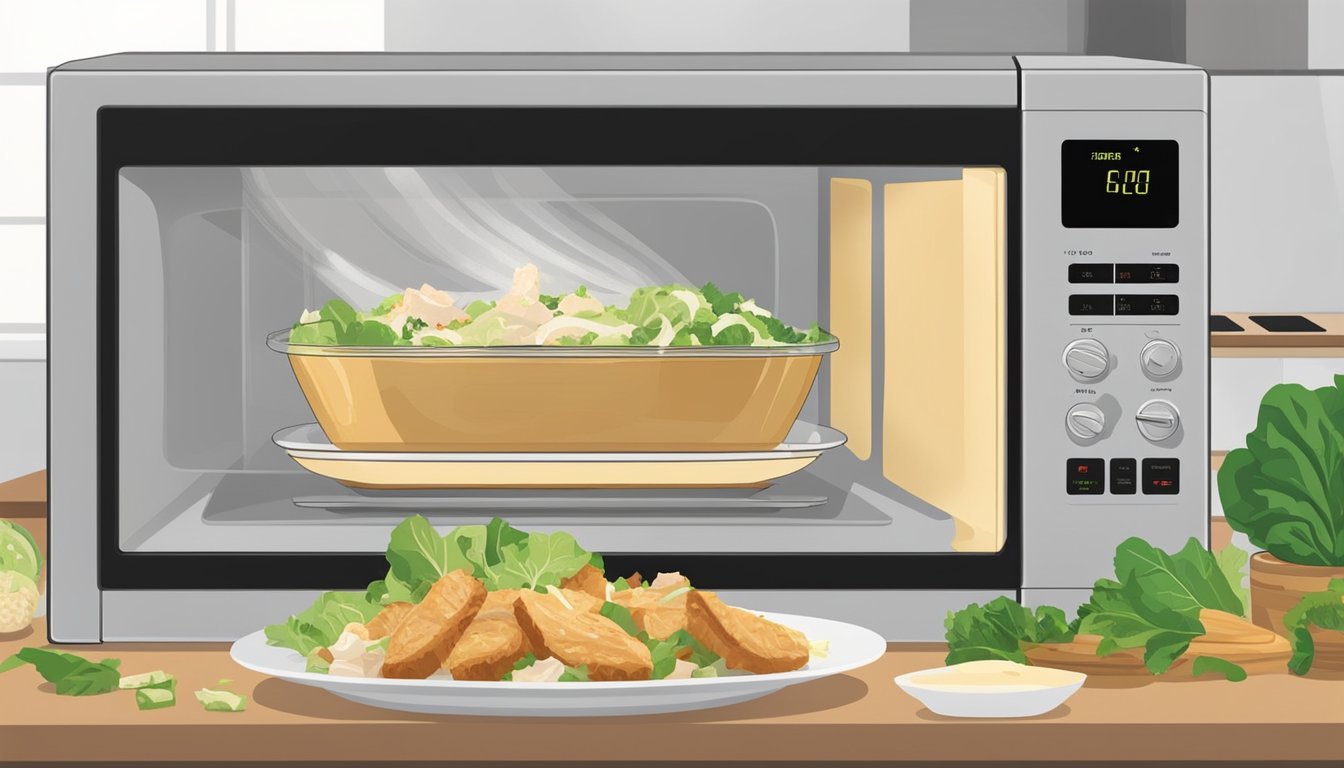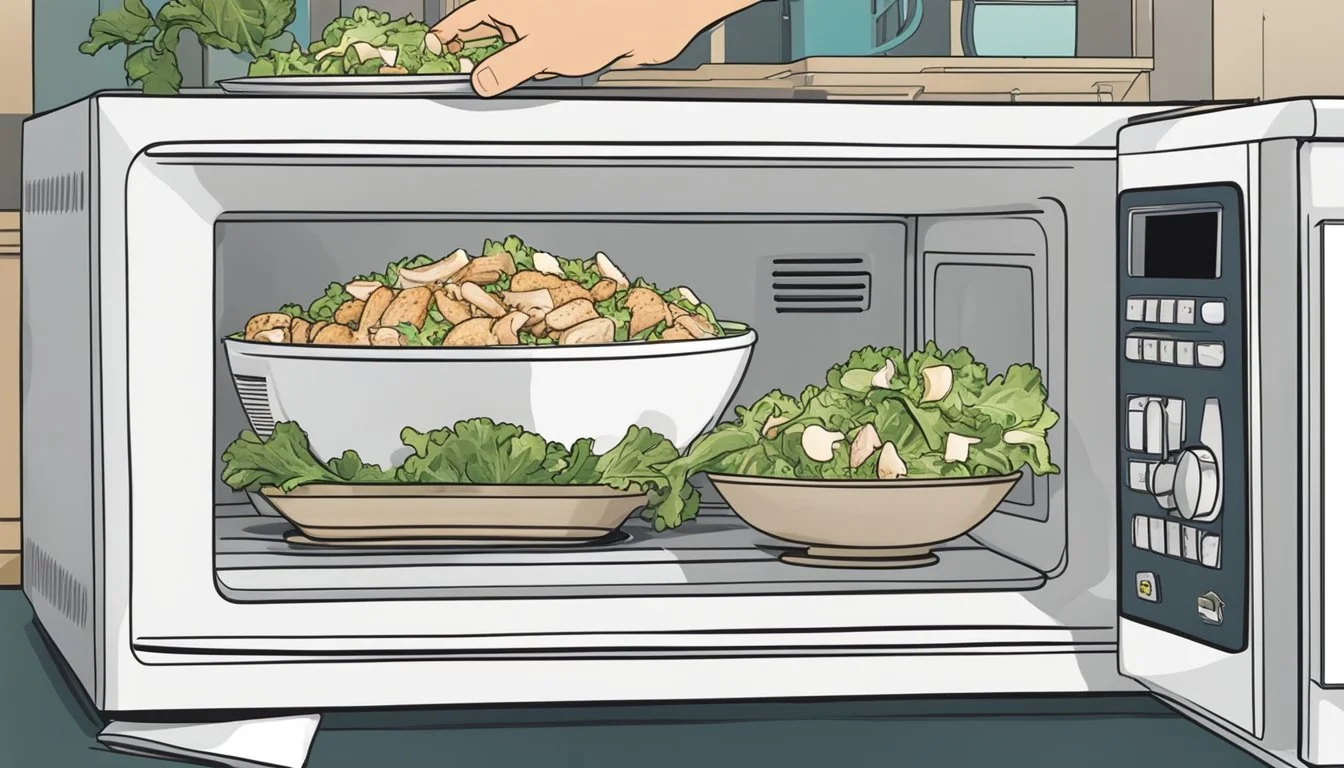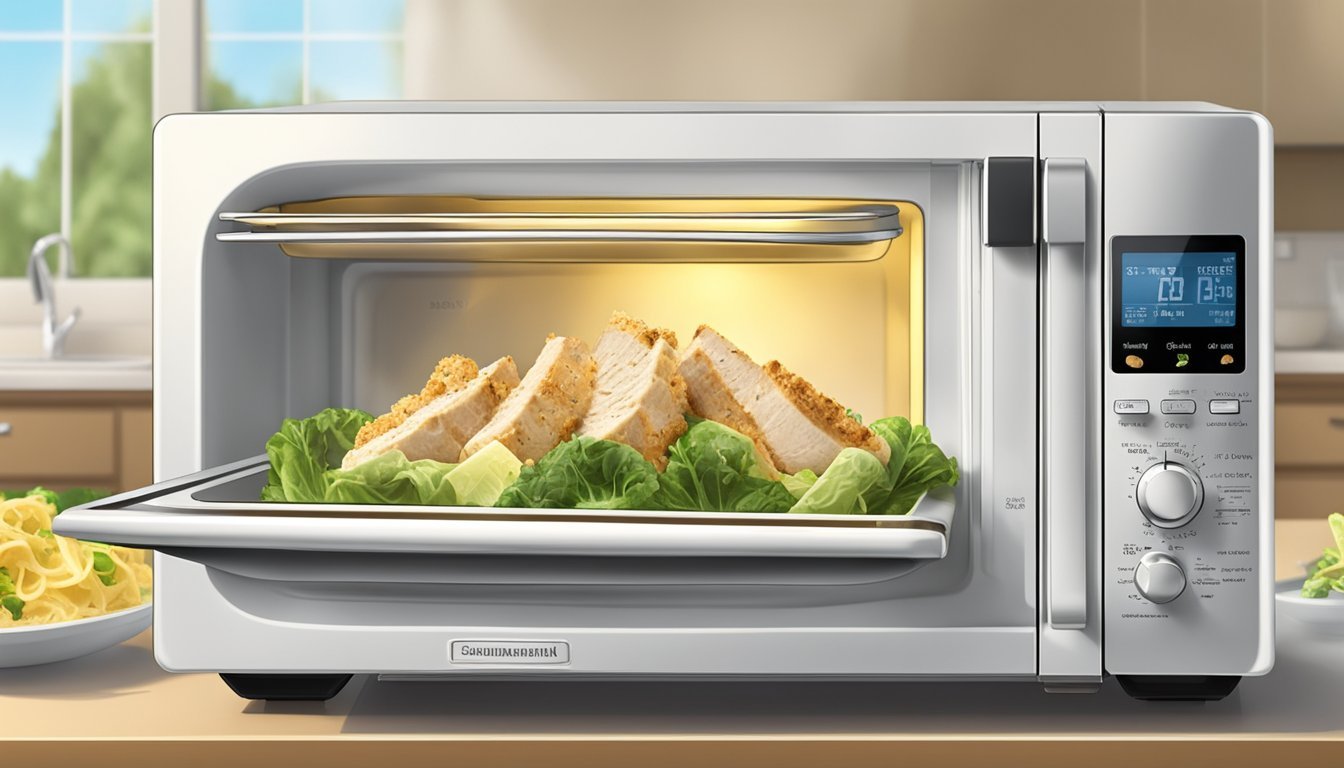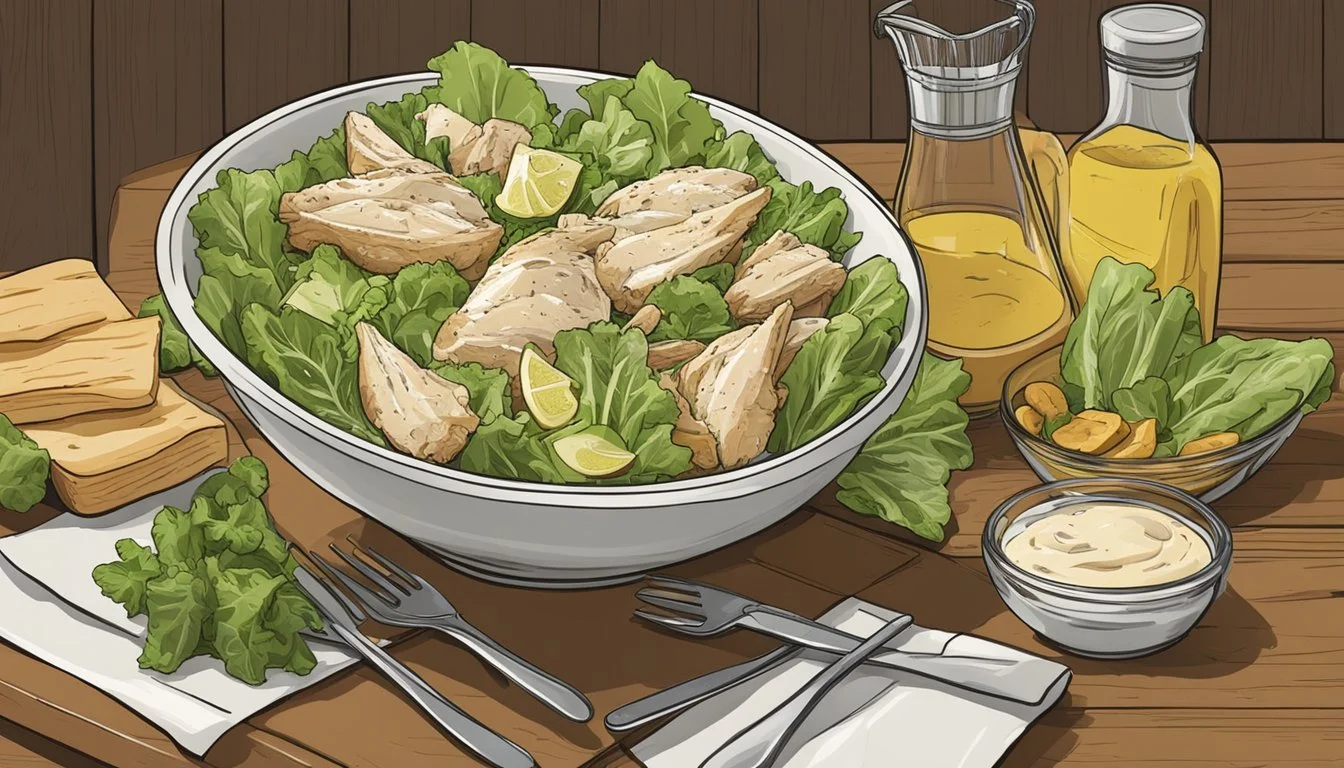How to Reheat Chicken Caesar Salad
Best Techniques Explained
Reheating a Chicken Caesar Salad can transform your lunch or dinner into a satisfying meal without losing its delicious components. If you have a leftover chicken Caesar salad that you’re planning to enjoy later, knowing the proper reheating techniques is essential to maintain its flavors and textures.
The best methods to reheat chicken Caesar salad involve using either an oven or a microwave. For optimal results, keep the vegetables dry and add them fresh after reheating to avoid sogginess. Whether for a quick lunch or a hearty dinner, evenly reheating the chicken and mixing in freshly added veggies will ensure a meal that’s both tasty and appetizing.
In the oven, use a low temperature to prevent the salad from drying out. Covering the dish with aluminum foil can also help retain moisture. For those who prefer a quicker method, microwaving the salad while stirring it halfway through can evenly warm the chicken, making it a convenient choice.
Understanding Chicken Caesar Salad
Chicken Caesar Salad is a popular dish known for its rich flavors and nutritional balance. Key components include romaine lettuce, grilled chicken, and the distinctive Caesar dressing. The dish also has an interesting history and offers notable health benefits.
Components of a Classic Chicken Caesar Salad
A traditional Chicken Caesar Salad features a few essential ingredients:
Romaine Lettuce: Offers a crisp texture and is nutrient-dense.
Grilled Chicken: Adds protein and enhances the salad's heartiness.
Croutons: Provide crunch and are usually toasted bread seasoned with olive oil and garlic.
Parmesan Cheese: Contributes a rich, salty flavor.
Caesar Dressing: Made from a blend of lemon juice, olive oil, garlic, and often anchovy fillets.
Together, these components create a well-balanced, flavorful salad.
Nutritional Value and Health Benefits
Chicken Caesar Salad is not just delicious but also nutritious:
Protein: Grilled chicken is a great protein source for muscle health.
Vitamins and Minerals: Romaine lettuce is rich in fiber, vitamins A, K, and C.
Healthy Fats: Olive oil and Parmesan cheese add essential fats beneficial for overall health.
Despite its richness, Caesar salad can be a part of a balanced diet. It's essential to watch the portion size and dressing quantity to keep fat and calorie intake in check.
History and Origin of the Caesar Salad
The origins of Caesar Salad trace back to Tijuana, Mexico, in the early 1920s:
Invented by Caesar Cardini: An Italian immigrant and restaurateur credited with creating the salad during a 4th of July rush.
Original Recipe: Initially, it did not include chicken. The classic recipe consisted of romaine lettuce, croutons, Parmesan cheese, and Caesar dressing.
The addition of grilled chicken came later, evolving the dish into the popular Chicken Caesar Salad known today.
Pre-Reheating Preparation
Proper preparation steps are essential to retain the flavors and textures of a Chicken Caesar Salad. Key points include optimal storage techniques and the separation of ingredients to maintain freshness and quality during reheating.
Proper Storage Techniques
For the best results, store each component of the Chicken Caesar Salad separately. This helps preserve the texture and flavor of each ingredient.
Lettuce should be thoroughly dried before storage. Excess moisture can lead to soggy leaves, compromising the salad's freshness. Placing the lettuce in an airtight container with paper towels to absorb any residual moisture is highly effective.
Chicken needs to be stored in a separate airtight container. This prevents the transfer of moisture, which could affect other ingredients. Additionally, the chicken should be cooled to room temperature before being stored in the fridge. This helps in even reheating later.
Homemade croutons and dressing should also be stored separately. Croutons in a dry, airtight container will maintain their crunch, while the dressing can be stored in a small jar or sealed container to keep it fresh.
Separation of Ingredients
Separating ingredients is crucial when preparing to reheat Chicken Caesar Salad. This method ensures that each element retains its intended texture and flavor.
Start by removing lettuce from the main salad. Store it in a salad spinner or wrap it in paper towels before placing it in an airtight container in the fridge. This approach prevents moisture buildup.
Chicken pieces can be reheated alone before being added back to the salad. By doing this, the chicken heats evenly without affecting other ingredients. It is important to reheat the chicken to an internal temperature of 165°F to ensure it is safe to eat.
Croutons can be refreshed in an oven or toaster to regain their crunchiness. Just a few minutes at a low temperature should suffice.
Storing the dressing separately prevents the salad from becoming soggy over time. Since the dressing is often thicker, storing it in a small container keeps it ready for quick mixing once the salad is reheated.
Reheating Methods for Chicken Caesar Salad
There are several effective methods to reheat chicken Caesar salad, each with its own advantages. The oven method maintains crisp lettuce, while stovetop techniques ensure tender chicken. The microwave method offers convenience but requires care to avoid sogginess.
Oven-Based Technique
To reheat chicken Caesar salad in the oven, preheat to a low temperature, around 275-300°F. Separate the chicken from the salad. Place the chicken on a baking sheet, covering it with aluminum foil to prevent drying out. Heat until the internal temperature reaches 165°F.
For the lettuce, it’s essential to keep it separate to maintain its crispness. Store the lettuce in the refrigerator until ready to serve. Once the chicken is heated, allow it to cool slightly before mixing it back with the fresh, chilled lettuce.
Stovetop Reheating Strategy
For stovetop reheating, a skillet is the preferred tool. Over medium heat, add a small amount of olive oil to the skillet. Remove the chicken from the bone if necessary and place it in the skillet. Stir and flip the chicken pieces to ensure even heating. Continue until the chicken reaches an internal temperature of 165°F.
When reheating on the stovetop, it's crucial to avoid overheating to keep the chicken tender. The lettuce should remain in the refrigerator to stay crisp. Once the chicken is reheated adequately, let it cool before adding it back to the fresh lettuce.
Microwave Reheating Tips
To reheat in the microwave, place the chicken and salad components in a microwave-safe container. Ensure the chicken is separated from the lettuce. Cover the chicken with a damp paper towel to retain moisture and microwave on high for 1-2 minutes, stirring halfway through.
It's essential to monitor the reheating process to prevent the chicken from becoming soggy. Once the chicken is adequately reheated, allow it to cool to avoid wilting the lettuce. Add it back to the fresh, cold lettuce for serving.
Enhancing and Preserving Flavors
To reheat a Chicken Caesar Salad without compromising its taste and texture, attention to detail is crucial. Addressing the lettuce and croutons, the dressing, and re-seasoning will ensure the salad retains its original flavor and appeal.
Avoiding Sogginess in Lettuce and Croutons
To maintain the crispness of lettuce and croutons, separate them from the chicken before reheating.
Lettuce: Store it in a salad spinner or wrap it in paper towels to absorb excess moisture, then place it inside an airtight container in the refrigerator. When ready to reassemble, the lettuce should still be fresh and crunchy.
Croutons: Keep croutons in an airtight container at room temperature. If they become soft, place them in the oven at 350°F for a few minutes to restore their crunchiness.
Dressing Considerations
The Caesar dressing, with its rich blend of flavors, can make or break the reheated salad.
Preparing the Dressing: A homemade version combining fresh lemon juice, garlic, anchovies, olive oil, and a blend of dijon mustard, Worcestershire sauce, and seasonings will enhance the taste.
Reapplication: Lightly reapply the dressing after reheating to maintain a creamy texture and taste. Adding a bit of fresh lemon juice just before serving can also revive the flavor.
Re-seasoning After Reheating
After reheating, it's essential to ensure the flavors of the chicken and dressing are at their peak.
Chicken: Season the chicken after reheating with a sprinkle of kosher salt, black pepper, and, if needed, a pinch of garlic powder. Doing so compensates for any flavor loss during the reheating process.
Final Touches: Taste and adjust the seasoning before serving. This might include an extra dash of freshly ground black pepper or a bit of fresh lemon juice, depending on personal preferences.
By focusing on these elements, a reheated Chicken Caesar Salad can come close to its original taste and texture. The attention given to lettuce and croutons, thoughtful dressing application, and careful re-seasoning make all the difference.
Final Touches and Presentation
Perfecting the final touches and presentation of a reheated Chicken Caesar Salad involves careful reassembly, thoughtful garnishing, and strategic serving approaches to enhance both visual appeal and taste.
Reassembling the Salad
Start with a clean, wide bowl to give the salad a fresh and organized appearance. Begin by layering the greens, placing the reheated chicken on top. Lightly toss to ensure even distribution.
Mix in fresh ingredients like finely grated parmesan cheese, crispy bacon, and sliced cucumbers to add texture and flavor. For added freshness, consider adding cherry tomatoes and lemon wedges. Ensure the greens are not wilted to maintain a crisp bite.
Garnishing for Visual Appeal
Garnishing is key to a visually appealing presentation. Use finely grated parmesan cheese and sprinkle it evenly across the salad. Add a handful of crispy bacon bits on top.
Place lemon wedges around the bowl’s edge for a pop of color. Freshly ground black pepper and a drizzle of olive oil can also enhance appearance and flavor. Strategic placement of cherry tomatoes can add vibrant color and make the dish more inviting for guests.
Serving Suggestions
Choose a large, shallow bowl for the main course, or individual bowls for side dishes. Make sure each serving includes a balanced portion of each ingredient.
For a side dish, pair your salad with warm bread or garlic toast. If serving as a main course, consider accompaniments like a light soup or grilled vegetables. This not only complements the meal but also provides variety.
Encourage guests to mix the salad before eating to blend flavors and textures. Proper serving methods will elevate the dining experience, making the reheated Chicken Caesar Salad as delightful as when it was first prepared.
Safety Tips and Best Practices
Proper handling and storage of a Chicken Caesar Salad can help maintain its freshness and safety. By following best practices for leftovers and reheating, you can ensure your meal remains appetizing and safe to eat.
Understanding Food Safety
When dealing with leftovers, especially salads with meat, observing food safety rules is crucial to prevent foodborne illnesses. Store the salad in the refrigerator within two hours of preparation to reduce bacterial growth. Always keep the salad at or below 40°F.
Reheat the chicken separately to an internal temperature of 165°F to kill any bacteria. Using a food thermometer can ensure accuracy. Avoid reheating lettuce with the chicken to preserve its texture and nutritional value.
Making the Salad Last Longer
To extend the salad's shelf life, store components separately. Keep lettuce in a salad spinner or wrap it in paper towels and place it in an airtight container. This prevents wilting by absorbing excess moisture.
Chicken should be stored in a separate container to prevent cross-contamination. If prepped as part of a make-ahead meal, consider storing the dressing in a small, tightly-sealed jar. Add it to the salad just before serving to maintain freshness.
Homemade Caesar Salad Dressing Recipe
Creating a homemade Caesar salad dressing is simpler than you might think. This section outlines key ingredients, step-by-step preparation, and tips for storing the dressing.
Ingredients Required
To make a great Caesar salad dressing, you need specific ingredients. Mayonnaise gives the dressing a creamy consistency. Anchovy fillets provide a distinct umami flavor. Lemon juice adds a tangy note, while Dijon mustard offers a subtle spiciness. Garlic is essential for its robust flavor. Olive oil ensures a smooth texture. Parmesan cheese enhances the dressing with a savory touch. Worcestershire sauce introduces a complex depth of flavor. Black pepper rounds off the taste with a hint of spice.
Below is a list for easy reference:
1 cup mayonnaise
2 anchovy fillets, minced
2 tablespoons lemon juice
1 tablespoon Dijon mustard
1 garlic clove, minced
1/2 cup olive oil
1/4 cup grated Parmesan cheese
1 teaspoon Worcestershire sauce
Freshly ground black pepper, to taste
Step-by-Step Preparation
Start by mincing the garlic and anchovy fillets until they form a paste. In a medium bowl, whisk together the garlic-anchovy paste, lemon juice, Dijon mustard, and Worcestershire sauce. Gradually add the mayonnaise and mix until smooth.
Next, slowly drizzle in the olive oil while continuously whisking to emulsify the mixture. Add the Parmesan cheese and mix until well-combined. Season with black pepper to taste. For a smoother texture, you can use a blender or food processor.
Taste the dressing and adjust the seasoning if necessary. The fresh and zesty taste of lemon, combined with the savory flavors of garlic, anchovies, and cheese, should shine through.
Storing Dressing for Future Use
To store the homemade Caesar salad dressing, transfer it to an airtight container. Place the container in the fridge, where the dressing will keep for up to one week. Make sure the container is tightly sealed to maintain freshness.
When ready to use, give the dressing a good stir. The ingredients might settle or separate slightly. Do not leave the dressing at room temperature for extended periods, as it can spoil.
Enjoy this dressing over cos lettuce with streaky bacon and other classic Caesar salad ingredients for a delightful meal.
Conclusion
Reheating a Chicken Caesar Salad while maintaining its freshness can be done with care.
Recap of Steps:
Separate Ingredients: Remove the chicken from the salad to reheat separately.
Reheat Chicken: Use a microwave, oven, or stovetop.
Combine and Serve: Reassemble the salad with the reheated chicken.
These steps ensure that the lettuce remains crisp and the chicken is warm.
Nutritional Info: Reheating should not significantly alter the nutritional content. Keep in mind, using added oils or dressings during reheating can increase calorie intake. Opt for minimal use of these additions.
Restaurant-Quality: To achieve restaurant-quality results, using an oven to reheat the chicken can offer a crispy texture without compromising the greens. Covering the dish helps retain moisture.
Home-Cooked Care: Using a stovetop over medium heat can provide controlled reheating, allowing for a home-cooked meal that doesn’t sacrifice taste or texture.
By following these guidelines, one can enjoy a Chicken Caesar Salad that retains its quality, whether reheated at home or sourced from a restaurant.










